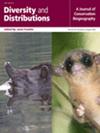Identifying Spatial Patterns of Egg Nursery Habitat for a Demersal Shark in the Northwestern Mediterranean Sea: Conservation and Management Implications
Abstract
Aim
Oviparous elasmobranchs lay benthic eggs with long incubation periods, many of which also require habitat-forming sessile organisms for their development. However, they are threatened by bottom-trawling fishing impacts. Here, we aimed to identify the suitable habitat distribution of small-spotted catshark (Scyliorhinus canicula) egg nursery areas, assess their current protection extent by an existing no-take MPA network and their coverage by other delimited spatial-based conservation areas.
Location
Balearic Sea, northwestern Mediterranean.
Methods
Egg cases were collected over 5 years (2018–2022) by a bottom-trawling monitoring programme along the eastern coast of the Iberian Peninsula. We used these occurrences and various environmental variables (bathymetry, slope, sea bottom temperature, sea bottom dissolved oxygen and seabed type) to model the habitat suitability of egg nurseries for the species using maximum entropy modelling.
Results
Sea bottom temperature was the most important variable explaining habitat suitability of egg nurseries. Small-spotted catshark eggs were found either attached to or in the same samples as various species of habitat-forming sessile organisms. We found only 3.6% (381 km2) of the modelled suitable egg nursery habitat in the Balearic Sea to be currently covered by an implemented no-take MPA network. At the same time, 52% of said MPAs are inadvertently protecting suitable egg nursery habitats (and their associated benthic community), as they were not initially planned with elasmobranchs as conservation targets. Important shark and ray areas (ISRA-IUCN) were also observed to cover egg nursery habitat (4502 km2 or 15.52%) within their boundaries.
Main Conclusions
While half of the current MPA surface is providing protection to this elasmobranch species' egg nursery areas and their associated benthic communities, they are not sufficient for their conservation. However, mapping the distributions of these essential fish habitats can help towards the 2030 European conservation target of ‘strictly protecting’ 10% of marine environments.


 求助内容:
求助内容: 应助结果提醒方式:
应助结果提醒方式:


